
Features
Aggregates
Profiles
Aggregates for green energy
A sand and gravel operation has supplied over a million tonnes of aggregates to Canada’s biggest win
May 1, 2009 By Andy Bateman
The Melancthon EcoPower Centre is described as the country’s biggest
wind installation to date, generating enough electricity to power some
70,000 average homes.
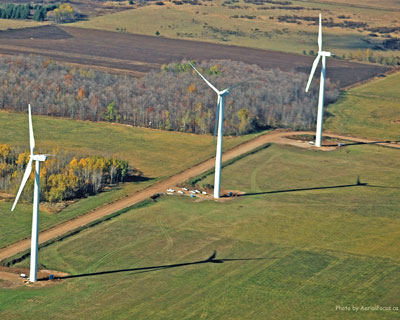 |
| Over 1 million tonnes of aggregates have been used to construct access roads and crane pads at Canada’s biggest wind generation project.
|
The Melancthon EcoPower Centre is described as the country’s biggest wind installation to date, generating enough electricity to power some 70,000 average homes. Located two hours northwest of Toronto near Shelburne On., the power centre’s 133 generators are spread over an extensive area and the aggregates supplied have been utilised mostly for the construction of an extensive network of access roads to individual turbine sites. As owner Canadian Hydro Developers Inc. notes, “Turbine siting is a finicky, technical business involving evaluation of site topography, long-term wind data (including speed, direction, air pressure, temperature, and variations of these according to time of day and season etc.), proximity to access roads and electrical transmissions lines, and other factors.” Before the site assembly of the generators can even begin, site preparation includes the construction of the access roads and working area at each location to allow construction of a concrete foundation. Depending on the specific turbine site, access roads may be relatively short from an existing paved road or a common access road may serve several generator sites, each with a short spur road.
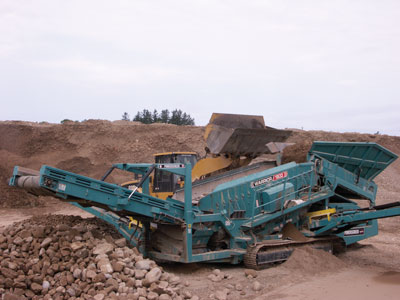 |
| This Powerscreen Warrior 1800 portable screening plant was producing Granular B base material from pit run at a rate of 4,000 tonnes-day. |
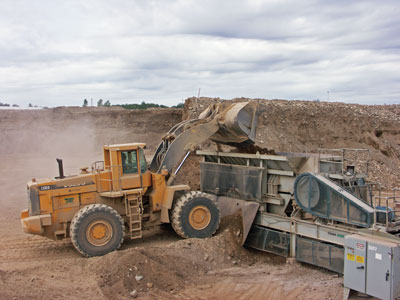 |
| A Volvo L330D wheel loader fed 4,000 to 5,000 tonnes of pit run to the Lippmann primary jaw crusher of Strada’s spread in a typical nine hour shift. |
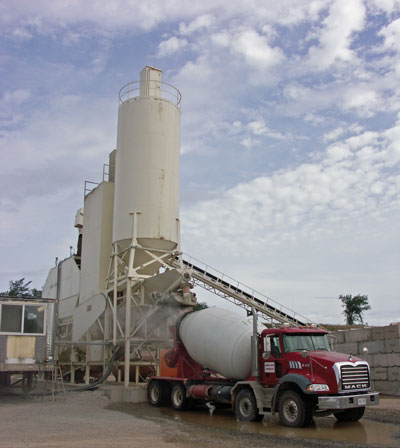 |
| The Con-E-Co Lo-Pro portable concrete plant of James Dick Concrete has been a principal supplier for Melancthon’s generator foundations. |
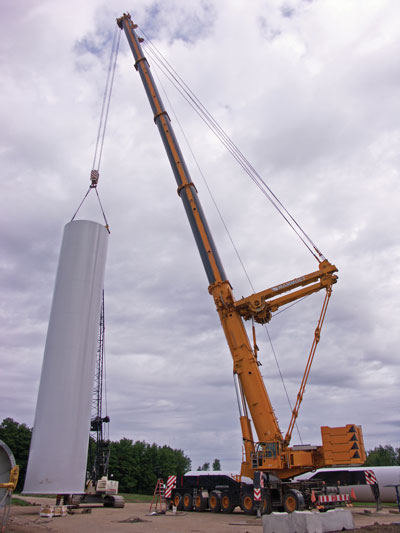 |
| A Terex Demag AC 500-2 telescopic boom crane was used for moderate lifts on the Melancthon project. |
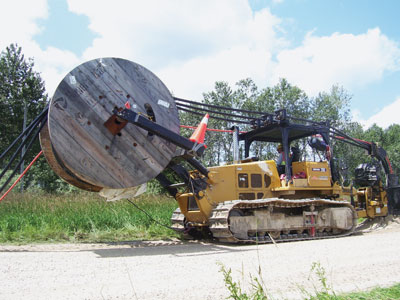 |
| An RWF Industries Bron 250 installing power cables on the Melancthon project in 2008. |
Tom Newson is manager of the sand & gravel division of Strada Aggregates and explains that the company’s Shelburne pit has supplied over 1 million on tonnes of granular base materials to the project for the construction of access roads and crane pads over the last three years. The unpaved access roads consist of a Granular B sub base and a surface lift of Granular A base material. Haul distances to the project have been relatively short, with typical hauls within a 14 km radius of the pit. Daily aggregate shipments averaged 8,000 tonnes to 10,000 tonnes during the construction season utilising a fleet of up to thirty trucks. At the time of Aggregates & Roadbuilding’s visit to the Shelburne pit, three aggregate spreads were in production at the same time. The main spread, Strada’s own, was producing Granular B base material as well as HL6 coarse aggregate for other company use and screenings. Nearby, two contractor’s screening plants were producing Granular A and Granular B respectively from pit run.
In operation, the Volvo L330D loader feeding Strada’s spread discharged pit run into a Lippmann primary jaw crusher. From there, primary crusher run was directed to a Terex 6 by 20 horizontal screen where Granular B was discharged off the rear of the screen and stockpiled. All the remaining material continued forward to an Astec Mobile Screens PEP Duo-vibe screen where the screenings produced by secondary crushing were separated and stockpiled. Material retained on the Duo-vibe screen was directed to a horizontal JCI 6 by 20 screen where HL6 aggregate was separated and stockpiled while oversize was directed to a JCI 1400 cone crusher in closed circuit with the secondary screening system. The reported production rate of the spread in this configuration and product mix was 450 tonnes-h for typical daily output of 4,000 to 5,000 tonnes in a nine hour shift.
Newson adds that the Shelburne pit is relatively new, having been in operation for only five years. There are 100 acres of the pit which are currently licensed and the owners are in the process of licensing another 160 acres. This site is also one of those relatively rare instances where both unconsolidated and consolidated deposits are present. In this case, there is a limestone deposit underneath the sand and gravel and long term site development could include a limestone quarry.
Canada’s biggest wind project
The two phases of the Melancthon EcoPower® Centre, Melancthon I and Melancthon II, have a combined total of 133 wind turbines generating 199.5MW of electricity. Annual average long-term generation from the centre is expected to be 545 GWh or enough to power approximately 70,000 average homes. The centre is located in Melancthon and Amaranth Townships, near Shelburne, Ontario, two hours northwest of Toronto.
Melancthon I, the $126 million 67.5 MW first phase of the project, went into commercial operation on March 4, 2006 and consists of 45 GE wind turbines, each rated at 1.5 MW for a total capacity of 67.5 MW. Melancthon I will generate enough green power to supply more than 25,000 households each year and is Ontario’s first utility-scale wind plant.
Melancthon II, the project’s $285 million, 132 MW second phase, achieved commercial operation on November 24, 2008. It consists of 88 GE wind turbines of which 22 are part of the Melancthon I Expansion Project and the other 66 make up the Melancthon II Wind Plant. The 88 turbines are each rated at 1.5 MW for a total capacity of 132 MW or enough green power to supply more than 50,000 average households each year.
The Melancthon EcoPower Centre is 100% owned and operated by Canadian Hydro Developers Inc., which describes itself as the largest and most diversified developer, owner, and operator of 20 power generation facilities in Canada. These facilities have a total net 496 MW of generating capacity in operation, 385 MW in and nearing construction, and 1,632 MW in development, as at November 28, 2008. The renewable generation portfolio is diversified across three technologies; water, wind, and biomass in the provinces of British Columbia, Alberta, Ontario, and Quebec. This portfolio is unique in Canada as all facilities are certified under Environment Canada’s EcoLogoM Program.
| The role of construction materials Gravel access roads are required to connect each wind turbine site to existing public roads during both the construction and operation phases of the project. On the Melancthon II project, wind turbines are typically located 120 metres or more away from roads in largely agricultural areas. In addition to the access roads, gravel fill has been used for the construction of crane pads, turbine foundation installation and site grading. The construction access roads are typically 12m wide, with stripped topsoil temporarily stored nearby for rehabilitation of lands affected by construction. The gravel roadbase is some 0.50 m to 1.0 m deep, consisting of 0.40 m or more of Granular B sub base material and 0.1m of Granular A base material. The access roads have been widened where necessary to allow the turning of large construction vehicles such as transport trucks delivering blades, towers, and nacelles (the structure housing the generator components). A typical turbine foundation consists of a poured in place reinforced concrete raft, sized to suit local ground conditions. The rafts are octagonal in shape with a diameter of 15m to 17m and 1m to 2m thickness, with the larger foundations requiring up to 400m3 of concrete. Each foundation incorporates a turbine tower pedestal 4m in diameter and anchored to the concrete foundation using 140 large diameter anchor bolts. Once completed, the foundation was backfilled and compacted with select fill and subsoil. Depending on weather conditions, the typical schedule for foundation construction included two to three days for excavation, about one week for formwork, rebar and concrete placement followed by a 14-21 day curing period for the concrete in the foundation and pedestal prior to erection of the turbine. Each turbine consists of an 80m steel tube tower, three 37m blades, the nacelle, rotor hub, and step-up transformer. The towers were delivered to the site in three sections and assembled using a 500 tonnes capacity crane for the bottom two sections and a 660 tonnes capacity heavy-lift crawler crane to erect the third tower section. The nacelle arrived on site assembled and was lifted into place by the heavy-lift crane. The rotor hub consists of the nose cone and the three blades, and was hoisted into place by two tailing cranes; the heavy-lift crawler crane did the heavy lifting, while 80 tonnes capacity smaller cranes stabilized the component as it was being lifted. The blades were delivered on an oversize vehicle some 45m long, the nacelle on an oversized vehicle approximately 35m long, and the towers on an oversized vehicle of sufficient capacity to carry the respective sections. Delivery of the main turbine components involved up to seven oversized vehicles per site: one to move the nacelle, two or three to move the blades and three to transport the tower sections. Due to their size and weight, the heavy lift crawler cranes arrived on site in multiple pieces requiring 20-30 individual transports and were then assembled on site over a period of two to three days. In addition to the cranes, a number of flatbed trucks and specialty trucks delivered both the smaller cranes and remaining turbine components. |
Print this page